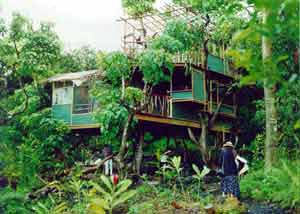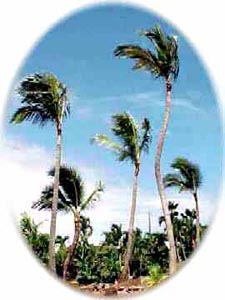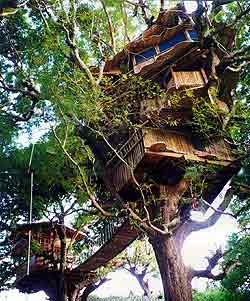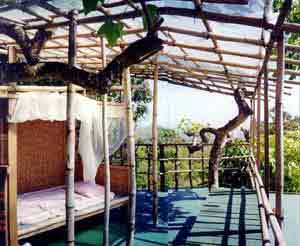Former
International Competition Program
Design a Treehouse for a Tropical Island Resort
Sponsored by Treehouses of Hawaii and arcspace.com
Treehouses
of Hawaii and arcspace.com invited architects and architecture
students around the world to design a “Treehouse for a Tropical
Island Resort”.
Deadline January 15, 2001, a little too late for the competition but
the program is valid for IDC Architectural Design I & II.
 Treehouse in Hawaii
Treehouse in Hawaii
David Greenberg
built his first treehouse five years ago at the Hana,
Maui, Hawaii Resort. The first stage of treehouses on Hainan Island in
the South China Seas is scheduled to open this month. Construction
will start in the near future in the Province of Hue in Vietnam and in
Fiji. One hundred new Treehouses are planned for construction in 2001.
The treehouses are used as vacation rentals.

Coconut Trees
The competition
sites are on the beaches of Fiji, Vietnam, China and Maui where there
are no existing trees. The majority of the Treehouses will be in
Coconut Palm trees that will be brought to the site and transplanted
as per the design. The tree size is the designers choice; they can
vary from 10 feet to 45 feet in height.
You must consider that all Palm Trees grow from the top up; a
construction in a palm tree 2 feet from the ground will never move up.
All connections to a tree must be in the form of a stainless steel
sleeve about 1/4" thick and about 10" high.
For the high decks it is not a good idea to make rigid connections
between all the trees as the trees can be blown in different
directions and fight each other in high winds.

Treehouse in China
The sites in
Southeast Asia are liable to have typhoons and heavy monsoon rains
which means you must design to resist heavy wind loads.
Basically you must use natural materials but, although tin is not
natural, corrugated tin is natural in the jungle as roofing material
because of the rain. You can also chose to design a roof of
vinyl/plastic that is stapled on and replaced every year. This kind of
roof also serves to let in light in the dark areas under the tree
canopies.

Sleeping in nature.
The sites and
climate allow for a close relationship to nature and an openness not
normally allowed in construction. There is almost no need for walls;
only for screening materials which are available locally in beautiful
colors.
The total floor
area should be between 500 and 1000 square feet and accommodate from
two to six people. No structural elements may touch the ground except
for access stairways.
For the construction there are several varieties of hardwoods in
China, Vietnam and Fiji. In Hawaii the building material is
predominantly structural bamboo.
The designs must
include a toilet and a shower of an ecological nature. The shower will
have propane water heaters, the toilets will for the most part be
compostable. You can incorporate the ground floor area for cooking and
showers.
Most sites may not have either sewage or septic systems; compostable
toilets could be specified.
Most sites will
not have electricity, even for construction. However, since good
handicraftsmen are plentiful, designs that emphasize craftsmanship are
encouraged.
Building codes
for treehouses have not yet been regulated in any of these countries.
The winning treehouses will be adjusted, when necessary, to make them
safe for human habitation.
A new section of
arcspace.com “Treehouse Competition” will post weekly information
related to the competition and the construction of treehouses.
Starting in November you can direct any questions to David Greenberg (intreehousecomp@yahoo.com).
A selection of questions will be answered and posted on a special
bulletin board at treehousesofhawaii.com
In the meantime
you can find plenty of resources if you search "Treehouses"
on your favorite search engine and your second favorite search engine
and....
Start off with:
Treehouses
International
Treehouse Out 'n'
About
The entries must
include Plans, Sections and Elevations in 1/4" scale as well as
sketches, significant details and any written information you may deem
important.
The winners will be asked to submit a 1/4" scale model.
P.S. For inspiration read "The Baron in the Trees" by Italo
Calvino; a wonderful fairy-tale about a young nobleman who lives his
entire life in the branches of the trees surrounding his estate.
For your
information:
If you use the
metric system the drawings and models must be in 1:50 scale.
1 inch (1")
= 2.54 centimeter
1 foot (1') = 30.48 centimeter
1 square inch = 6.45 square centimeter
1 square foot = 929 square centimeter
39.37 inches = 1 meter
3.28 feet = 1 meter
1 square foot = 0.09 square meter